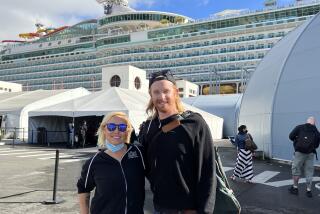No safe harbor from disembarkment syndrome

- Share via
Amanda Coronado wakes up every morning wondering whether she’ll be able to walk out of her bedroom.
It’s almost impossible on a bad day. The world is moving too much for her to keep her balance.
“I can’t just go for a run,” she said. “I can hardly find my feet.”
During the first week of August, Coronado took a cruise along the Mexican coast. Since stepping off the ship, that feeling of cresting, rolling waves has not gone away.
At first she thought it was funny.
Then a few days after her return from the cruise, a migraine struck. The swaying sensation intensified, and she could not walk. An emergency room doctor said she had mal de debarquement syndrome, a condition marked by a constant swaying sensation that can last for months or years and has no cure.
When she walks down store aisles, she feels as though they are rising up to hit her. In the shower, she feels as though it might cave in on her. Looking at the ocean now is intolerable for the beach lover and Orange County native.
In motion, she finds balance. Her commute between her home in Corona and her workplace in Rancho Santa Margarita has turned into a calmative.
“I feel like I went from 29 [years old] to 80,” she said, eyes welling. “I feel like I could benefit from a cane, but I don’t want to walk around with one.”
Looking up her symptoms online, Coronado found the MdDS Balance Disorder Foundation. She connected with its 1,200 online members and learned about the first federally funded research at UCLA.
Though not a study participant, she has found hope.
UCLA visiting assistant professor Dr. Yoon-Hee Cha is researching what happens in the brains of syndrome patients.
“It’s like a normal phenomenon, but it’s not normal for it to go on for a long time,” she said.
The syndrome most frequently occurs in people who have been on a boat or ship, but airplanes and long drives can also bring it on, Cha said. A few people have developed symptoms without a known trigger.
Lanie Fagan, director of communications for Cruise Lines International Assn., said such illnesses stem from how the ship moves. Newer hull designs, more efficient propellers and the size of cruise ships minimize movement, she said.
“Cruise ships are a very stable platform due to all of the innovations and size and equipment,” Fagan said. “Although it would be difficult to claim that no one got this illness after a cruise, we believe it is highly unlikely.”
The syndrome intrigued Cha because MRI and CT scans look only at brain structure, not brain function, and do not show abnormalities in syndrome patients.
“There was nothing known about the scientific basis for this disorder,” she said.
Patients have flown in from across the United States and Canada to take part in the research, but Cha currently has funds to study only 15 people who have disembarkment syndrome and 15 who do not.
Foundation creator Marilyn Josselyn, 74, flew from Pennsylvania to participate in the study that the group has helped to fund. Twelve years ago, she and her husband traveled by ship from St. Petersburg, Russia, to Moscow. She has felt at sea ever since.
“I’d do anything to get my life back,” she said.
At UCLA’s Ahmanson-Lovelace Brain Mapping Center and Reed Neurological Research Center, Josselyn watched dots moving randomly on a computer screen. She donned goggles that at first showed the same images and later a “Lord of the Rings” film, her choice, all while brain activity was monitored in an MRI machine.
In the last test, she was injected with a weak radioactive solution and her head held still for a scan that allows Cha to see how her brain metabolizes sugar.
Josselyn said she wishes more research could be funded and thinks cruise lines should warn passengers of this possible risk. Through the foundation, she has met many others whose lives are forever changed by the syndrome.
“This is not life threatening, but it is a debilitating syndrome and disease and life altering,” Josselyn said.
travel@latimes.com
More to Read
Sign up for The Wild
We’ll help you find the best places to hike, bike and run, as well as the perfect silent spots for meditation and yoga.
You may occasionally receive promotional content from the Los Angeles Times.






